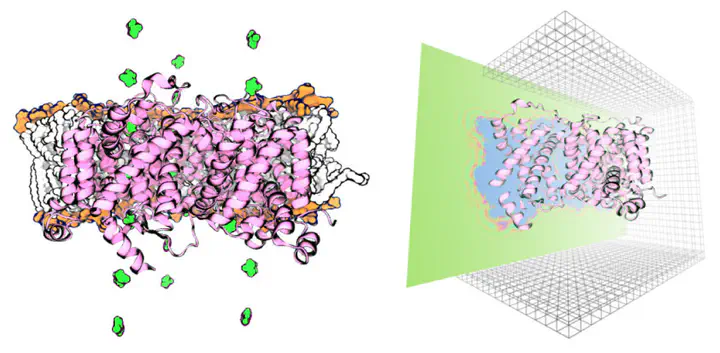Potential of Mean Force Calculations of Solute Permeation Across UT-B and AQP1: A Comparison between Molecular Dynamics and 3D-RISM

Abstract
Membrane channels facilitate the efficient and selective flux of various solutes across biological membranes. A common approach to investigate the selectivity of a channel has been the calculation of potentials of mean force (PMFs) for solute permeation across the pore. PMFs have been frequently computed from molecular dynamics (MD) simulations, yet the three-dimensional reference interaction site model (3D-RISM) has been suggested as a computationally efficient alternative to MD. Whether the two methods yield comparable PMFs for solute permeation has remained unclear. In this study, we calculated potentials of mean force for water, ammonia, urea, molecular oxygen, and methanol across the urea transporter B (UT-B) and aquaporin-1 (AQP1), using 3D-RISM, as well as using MD simulations and umbrella sampling. To allow direct comparison between the PMFs from 3D-RISM and MD, we ensure that all PMFs refer to a well-defined reference area in the bulk or, equivalently, to a well-defined density of channels in the membrane. For PMFs of water permeation, we found reasonable agreement between the two methods, with differences of $≲3\ kJ\ mol^{–1}$. In contrast, we found stark discrepancies for the PMFs for all other solutes. Additional calculations confirm that discrepancies between MD and 3D-RISM are not explained by the choice for the closure relation, the definition the reaction coordinate (center of mass-based versus atomic site-based), details of the molecule force field, or fluctuations of the protein. Comparison of the PMFs suggests that 3D-RISM may underestimate effects from hydrophobic solute-channel interactions, thereby, for instance, missing the urea binding sites in UT-B. Furthermore, we speculate that the orientational averages inherent to 3D-RISM might lead to discrepancies in the narrow channel lumen. These findings suggest that current 3D-RISM solvers provide reasonable estimates for the PMF for water permeation, but that they are not suitable to study the selectivity of membrane channels with respect to uncharged nonwater solutes.